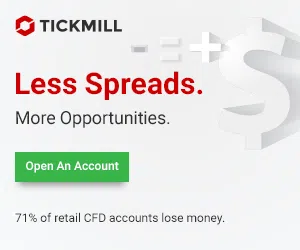-
Best Forex Brokers
Our top-rated Forex brokers
-
Brokers for Beginners
Start trading here
-
Demo Accounts
Learn to trade with no risk
-
Lowest Spread Brokers
Raw spreads & low commissions
-
ECN Brokers
Trade with Direct Market Access
-
Islamic Account Brokers
Best accounts for Muslim traders
-
Market Maker Brokers
Fixed spreads & instant execution
-
All Trading Platforms
Find a platform that works for you
-
MetaTrader4 Brokers
The top MT4 brokers in the UK
-
MetaTrader5 Brokers
Best MT5 Brokers in the UK
-
TradingView Brokers
Best TradingView Brokers
-
cTrader Brokers
The top cTrader brokers in the UK
-
Copy Trading Brokers
Copy professional traders
-
Spread Betting Platforms
Tax-free trading
-
Forex Trading Apps
Trade on the go from your phone
-
Forex Brokers in UK
Trading from UK? Discover our top-rated brokers here!
-
Forex Brokers in USA
Trading from USA? Discover our top-rated brokers here!
-
Forex Brokers in Canada
Trading from Canada? Discover our top-rated brokers here!
-
Forex Brokers in Dubai
Trading from Dubai? Discover our top-rated brokers here!
An introduction to Contracts for Difference
Contracts for Difference, or CFDs as they are commonly called, are very popular financial instruments with individual traders. But what exactly are they, how do you use them, and what are the advantages and disadvantages involved in trading CFDs? This article seeks to answer all these questions. By the time you’ve finished reading it, you should know whether CFDs are an instrument you would like to trade, and, if so, how to proceed.
What are CFDs?
CFDs allow traders to bet on short-term price movements in a wide variety of financial assets, from currencies to shares to cryptocurrencies, without actually owning or taking physical delivery of the assets. CFDs are contracts between a buyer (such as an individual trader) and a seller (like a broker, investment bank or spread-betting firm), under which the two parties agree to exchange the difference in the value of an underlying financial instrument between the time the contract opens and the time it closes – often over less than one day.
CFDs benefit from several features that make them uniquely valuable to individual traders. For example, imagine that a trader believes the price of shares in ACME is going to rise over the day’s trading. He or she enters into a contract with a CFD broker, agreeing to buy 100 shares in ACME at US$10 a share. But the broker lets the trader put up just 5% of the US$1000 overall value of the contract, or US$50. The shares rise in value by 10%, to US$11, so the overall value of the contract rises to US$1100, giving the trader an overall profit of US$100 over the day, double his US$50 outlay.
The ACME example highlights one of the key advantages and disadvantages of CFDs, as we explain below.
What are the advantages of trading CFDs?
Leverage: You don’t have to put up the full value of the contract but still benefit in full from any gains. In the example above, the broker provider leverage of 20 to 1 (20:1): the trader only had to put up 5% of the value of the contract and leveraged his money 20 times over. Leverage is generally offered in the range of 3% to 50% of the value of the asset. The amount you are required to put up (5% in this case) is known as the margin or the position margin.
Profit from falling and rising markets: You can use CFDs to bet that the price of an asset will rise (going “long” in the jargon) or that it will fall (going “short”). The latter option involves selling CFDs you don’t actually own and then buying them after the price falls so that you can complete the contract you made to sell them at the higher price. For example, suppose you believe ACME’s share price will fall to US$9 each. You agree to sell 100 shares in ACME at the current price of US$10 a share, again using the 20:1 leverage offered by the broker. By the end of the trading day, the price has indeed fallen to US$9 a share. That is when you step in and buy them, so that you have CFDs to sell for US$10 each to fulfil your earlier agreement. Once again, you have made US$100, or double your initial outlay.
Convenience: You can trade CFDs in a multitude of different assets without ever having to take physical delivery, saving on storage, security and transportation costs. For example, you can trade CFDs in gold, and simply profit from price changes in the commodity without worrying about how you are going to store it securely.
Moreover, there are no limits on using CFDs to “short” financial instruments. By contrast, some markets in particular instruments have rules that prohibit shorting or require the trader to borrow the instrument before selling short, or have different margin requirements for short and long trades, making it difficult to balance positions.
Flexibility: You can close a position at any time during the trading day. That means you can hold a position for as long as you want, be it seconds, minutes or hours. You can even hold a position overnight, although there will be a charge for doing so (see below for an explanation of the costs involved in trading CFDs). Moreover, many brokers offer a variety of options when it comes to trade size, allowing a wide range of traders to access the market. This includes beginners and casual traders seeking to experiment with investment strategies while limiting their risk by focusing on small trades.
Ability to hedge: Most people are familiar with the term “hedging your bets” and understand that it involves offsetting risks. Well, it means exactly the same thing in the financial world and is derived from the age-old idea of using a hedge – or fence – as a means of protection. In this instance, you can use CFDs as a way of offsetting your trading positions with balancing trades in case your beliefs about whether those initial positions are likely to rise or fall prove wrong. CFDs are ideal hedging tools because you can use them to bet that an instrument will rise or fall at a relatively low cost. So, you can take a long position in shares in XYZ that will profit should the price rise, while taking out a short position that will prove profitable should the XYZ share price fall. In other words, instead of selling XYZ at a loss should your expectation of the share price moving higher prove wrong (and draining your limited financial resources in the process), you can open an additional short position that will generate earnings to help offset any losses from your initial position.
You can also use CFDs to insure against a rise or fall in any investment you have other than CFDs. Suppose, for example, you have a standard portfolio of shares in global equities that you wish to keep invested for the long term. Now imagine you anticipate that global equities will soon encounter turbulence and fall sharply before correcting. You could sell all the shares in your portfolio in the belief that you’ll be able to buy them back at a much lower price. But that could prove costly in terms of transaction expenses and taxes, and it is risky: global equities might rise sharply and you might not then be able to buy them back at a lower cost. Alternatively, an investor fearing a market correction could short-sell an equivalent amount of CFDs in the same shares, enabling them to take advantage of the short-term downtrend. At the same time, the investor continues to hold the shares within the investment portfolio, in the belief they will thrive in the long term.
Exposure to a huge range of financial assets: You can use CFDs to gain exposure to thousands of underlying financial instruments around the world from just one platform.
Tax advantages: Unlike traditional share dealing, there is no stamp duty to pay on a CFD trade as you never take physical ownership of the underlying asset.
What are the disadvantages and risks of trading CFDs?
There are significant benefits to using CFDs to access the potential profits to be derived from trading financial markets, but there are also considerable risks that any would-be trader should be aware of before taking the plunge into trading these complex financial products.
Leverage: As we have seen, this is one of the main advantages of CFDs to traders, but ironically it also poses the main threat. Leverage exposes a trader to greater potential profits but also greater potential losses. Let’s use another example to explain why. Suppose you buy 10,000 CFDs in XYZ shares at 280 US cents. The broker provides you with leverage of 5:1 (or 20%), so instead of putting up US$28,000 to own the shares, buying CFDs allows you to gain exposure to the shares with just US$5,600 of your cash. The shares subsequently rise in price by 10%, to 308 cents, and the overall value of the position in those 10,000 shares is now US$30,800. An initial deposit of just US$5,600 has generated a profit of US$2,800, providing a 50% return on your investment, compared with just a 10% return if the shares were bought physically.
But what happens if the trade moves against you and the price of XYZ shares falls by 10%? At 252 cents per share, the overall value of the position is now US$25,200. An initial deposit of US$5,600 in CFDs has produced a loss of US$2,800, or 50% of your investment, compared with just a 10% loss if the shares were bought physically.
Moreover, if the capital in your account falls below a certain level, you may be subject to a “margin call”, where the broker asks you to put up additional funds to balance the account. If you fail to do so, it may close your positions, so crystallising your losses.
You can protect against potential losses to a certain degree. Brokers such as CMC Markets, for example, incorporate negative-balance protection into retail accounts, so your losses will be limited to the value of the funds in your account.
Constant monitoring: You need to be alert to possible changes in your position at all times. Market volatility and rapid changes in price – which could arise outside normal business hours if you are trading international markets – can cause the balance of your account to change quickly. If you do not have sufficient funds in your account to cover these situations, your positions will be automatically closed.
Market volatility and gapping: Financial markets can be very volatile and the prices of financial instruments can rise or fall precipitately at times, jumping to a much lower or higher price rather than moving gradually. This is called gapping and it can have a significant impact on traders. For example, traders may use stop-loss orders to limit losses. This involves specifying a price at which your position closes out if an instrument’s price goes against you. When gapping occurs, however, those stop-loss orders may be executed at unfavourable prices – either higher or lower than you may have anticipated, depending on the direction of your trade.
It is easy to take on too much risk: Because the cost of trading is low, due to leverage, it is easy for investors to be lulled into a false sense of security and take on more trades than is prudent. This can leave them overexposed to the markets at any given time, such that their remaining capital would be insufficient to cover losses across the portfolio. If multiple positions go wrong, it can spell financial ruin for those who adopt a less than cautious approach to CFD trading.
Lack of ownership: This is another characteristic of CFDs that brings benefits but also disadvantages. Because you don’t own the underlying asset, you can’t gain from the benefits of ownership, such as the income provided at set periods by shares or bonds. Even if you factor in forthcoming dividend declarations when buying CFDs in shares, for example, you will only benefit at a fractional rate compared with the payout involved in actual share ownership.
Limited advantages over time: Because of the above point and others, you should only view CFDs as a short-term trading strategy, rather than a long-term investment option. Overnight financing charges alone can render the cost of long-term ownership of long positions prohibitive.
Counterparty risk: This relates to the risk that the counterparty to the trade, the broker in the case of CFDs, could default on the deal. Such risk is minimised by choosing a reputable broker in a well-regulated legal environment, but it still cannot be overlooked.
Volatility can widen spreads… and costs: Severe volatility in markets or in a particular product can cause brokers to widen spreads, which will affect the prices paid by the trader when entering and exiting positions, potentially negatively impacting trades and increasing losses.
How do CFDs work?
CFD trading is relatively simple. Brokers provide the software that connects traders to the market. There are many to choose from and many factors to consider (see Choosing a broker). After selecting a broker, you log into their platform and select the financial instrument you wish to trade, having previously determined whether you believe the price will rise or fall.
You will always see two prices quoted for CFDs: the buy price (also known as the offer price), at which you can buy the contract from the broker or open a “long” position; and the sell price (or bid price), at which you can sell the contract to the broker or open a “short” position. Buy prices are always slightly higher than the current price quoted on the market, and sell prices are always slightly lower. The difference between the two prices is the “spread”, and this gives the broker a profit to make it worth their while dealing in CFDs. For example, ACME could be trading at a sell/buy price of 1,599/1,600 US cents, the sell price (i.e. the money you would receive for this CFD if you sold it to the broker) being slightly lower than the buy price (i.e. the money you would pay the broker to buy this CFD at the same moment).
Examples of profitable positions
It is important to know the costs involved in trading CFDs to determine whether a trade will be profitable.
Example A – long position
XYZ Enterprises is trading at a sell/buy price of 1,599/1,600 US cents. You think the price is going to rise and decide to buy 1,000 share CFDs because you want to profit from the gains. You only have to put forward 5% of the total position’s value from your own funds as the position margin. In this example, your position margin will be US$800, or 5% x 1,000 units x 1,600 cents buy price. Remember, though, that if the price moves against you, you may lose more than your initial position margin.
You are proved right and the sell/buy price rises to 1,625/1,626 cents over the next hour’s trading. You decide to close your position by selling at 1,625 cents (the new sell price). The price has moved 25 cents (1,625 minus 1,600) in your favour. Multiply this by the size of your position (1,000 units) to calculate your profit, which is US$250.
You also incur the following costs, based on a commission charge of 0.10%:
- 1,000 (units) at 1,600 US cents (price) x 0.10% = US$16.00
- 1,000 (units) at 1,625 US cents (price) x 0.10% = US$16.25
- Total commission = US$32.25
Therefore, your total profit for your successful trade on XYZ Enterprises is your gross profit minus total commissions:
- US$250.00 minus US$32.25 = US$217.75 net profit
Example B – short position
XYZ Enterprises is again trading at a sell/buy price of 1,599/1,600 US cents. This time you think the price is going to fall, so you decide to sell 1,000 share CFDs in order to profit from that fall in price. You only have to put forward 5% of the total position’s value from your own funds as the position margin. In this example, your position margin will be US$799.50, or 5% x 1,000 units x 1,599 cents sell price. Remember again, though, that if the price rises, you may lose more than this initial position margin.
The price does indeed fall in the next hour’s trading, to 1,549/1,550 cents. You decide to close your trade by buying back at 1,550 cents (the new buy price). The price has moved 49 cents (1,599 minus 1,550) in your favour. Multiply this by the size of your position (1,000 units) to calculate your profit, which is US$490.
You also incur the following costs, based on a commission charge of 0.10%:
- 1,000 (units) at 1,599 US cents (price) x 0.10% = US$15.99
- 1,000 (units) at 1,550 US cents (price) x 0.10% = US$15.50
- Total commission = US$31.49
Therefore, your total profit for your successful trade on XYZ Enterprises is your gross profit minus total commissions:
- US$490.00 minus US$31.49 = US$458.51 net profit
But what happens when your predictions for the price of a financial instrument prove to be wrong? The easiest way to see is by considering the two examples below.
Examples of losing positions
Example A – long position
Imagine you were wrong when you bought XYZ Enterprises at a sell/buy price of 1,599/1,600 US cents in the expectation that the price would go up. Some unexpected news causes the sell/buy price to fall to 1,549/1,550 cents over the next hour, and you believe the decline will continue. You try to limit your losses by closing your position at the new sell price of 1,549 cents.
The price has moved 51 cents (1,600 minus 1,549) against you, and you need to multiply this by the overall size of your position (1,000 units) to calculate your loss of US$510.
The total commission charges you incur are as follows:
- 1,000 (units) at 1,600 US cents (price) x 0.10% = US$16.00
- 1,000 (units) at 1,549 US cents (price) x 0.10% = US$15.49
- Total commission = US$31.49
So, your net loss on XYZ Enterprises is calculated by adding the cost of commissions to your gross loss:
- US$510.00 plus US$31.49 = US$541.49 net loss
Example B – short position
Now suppose you were also proved wrong when you sold XYZ Enterprises at a sell/buy price of 1,599/1,600 US cents in the expectation that the price would fall. Demand for the shares surges on an unexpected takeover bid, and the sell/buy price rises to 1,649/1,650 over the next hour. The signs are that the gains will continue, so you try to limit your losses by closing your position at the new buy price of 1,650 cents.
The price has moved 51 cents (1,650 minus 1,599) against you, and you need to multiply this by the overall size of your position (1,000 units) to calculate your loss of US$510.
The total commission charges you incur are as follows:
- 1,000 (units) at 1,650 US cents (price) x 0.10% = US$16.50
- 1,000 (units) at 1,599 US cents (price) x 0.10% = US$15.99
- Total commission = US$32.49
So, your net loss on XYZ Enterprises is calculated by adding the cost of commissions to your gross loss:
- US$510.00 plus US$32.49 = US$542.49.
What financial instruments can I trade with CFDs?
Below are the major financial assets you can gain exposure to via CFDs.
Currencies: These provide traders with a huge variety of options because currencies are traded in pairs against each other, such as the US dollar against the euro. There are hundreds of currency pairs available to trade via CFDs. The global market is huge with around $6.6 trillion traded every day in foreign exchange markets. So, the market in major currencies is highly liquid, meaning it is easy to get in and out of positions.
Shares: You can buy CFDs in most major global stocks. Like the forex market, the global share market is huge, with the total value of global equity trading worldwide amounting to 37.7 trillion U.S. dollars in the second quarter of 2021. Again, that means you can choose from a huge number of highly liquid shares. Price movement in shares can also be large and this volatility offers significant potential gains, as well as losses, for traders.
Indices: These provide a representation of an overall market. For example, a collection of different stocks are grouped together and an average price is taken for all of these stocks, creating the price of the index. Well-known examples include the Dow Jones and the S&P 500 in the US. CFDs provide a quick and convenient way to trade the overall stock market, or any other market, rather than via individual shares or components of the index. Indices tend to be less volatile than shares in individual companies and hence are less risky. They are also powerful forward-looking indicators for both global and country-specific economies so if you have a particular expertise in economic, indices could be for you. More the appeal of trading index CFDs, includes low trading costs and lower margin requirements, compared to stock CFDs – reaching as low as 1% in some markets.
Cryptocurrencies: You can trade a variety of popular cryptocurrencies with leverage, from Bitcoin and Ethereum to TRON and NEO. The global cryptocurrency is growing rapidly and is forecast to rise from US$1.49 billion in 2020 to reach US$ 4.94 billion by 2030. Prices are, however, highly volatile, magnifying the potential for large profits and losses. One of the key advantages of cryptocurrency CFDs is that you don’t own the underlying assets, thus preventing the risk of loss due to a cybersecurity breach.
Commodities: You can gain exposure to the hugely diverse range of commodities, from oil to gold to copper, using CFDs. Commodities are subject to a huge range of influences from global demand and supply to political shocks, that disrupt supply and demand, and are highly influenced by the economic cycle. Consequently, commodities are susceptible to sudden price movements that may present trading opportunities.
Again, this is a highly liquid and massive market. The underlying value of just the market in crude oil (the world’s most traded product) in 2019 – prior to the pandemic – was US$986bn
Bonds: Effectively IOUs issued by governments, companies and other entities, the bond market, also known as the fixed income market, because of the regular set payments these instruments provides, is another of the world’s biggest financial markets. Similar to stocks, bond CFDs provide exposure to a huge range of issuers. The fixed income market tends to be far less volatile than the stock market and key influences include the outlook for inflation and interest rates and the underlying creditworthiness of the issuer. One of the advantages of bond CFDs is that margin requirements can be as low as 20%, making them attractive to investors keen on using leverage to invest.
Interest rates: You can use CFDs to bet on the future direction of interest rates in a wide range of major global markets. The advantages of interest CFDs include relatively attractive margins of 20% and low spreads compared to other products.
Stay updated
This form has double opt in enabled. You will need to confirm your email address before being added to the list.

































